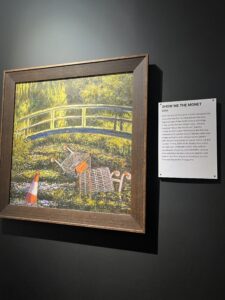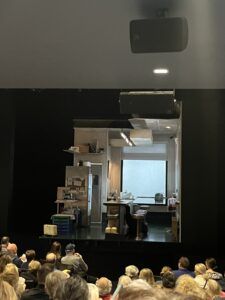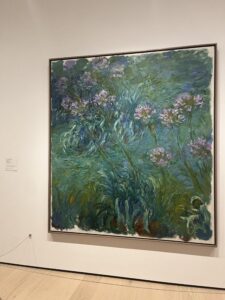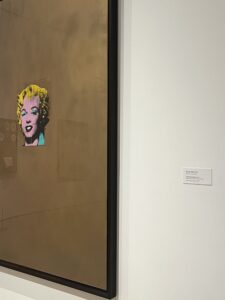

Author: Amanda Alencastro
Scenes From the Latin Quarter, Rent, Opera Lecture
The movie/musical Rent, Scenes From the Latin Quarter and the Opera presentation we viewed signify how topics can be discussed through different forms of expression. These themes include the depiction of Bohemian lifestyles and the struggles that follow those who lead them. I find it interesting that Rent in particular utilizes multiple art mediums to convey its message, as it is a musical with original songs adapted to fit a movie format. It tackles important aspects of Bohemian life in the 1980s such as poverty as an artist and unconventionality. This is similar to Scenes From the Latin Quarter, which mainly follows the lives of Rodolphe, Schaunard, and Marcello, who are all different types of artists. They face some similar struggles to those of the characters in Rent. However, Rent goes into depth specifically about the AIDs epidemic of the 1980s while Scenes From the Latin Quarter does not. Overall, Rent was easier for me to follow than the latter, potentially because of the fact that it is visual media. I also enjoyed the songs (side notes: the Macaulay Triplets are singing Seasons of Love at our concert!). The opera lecture was enjoyable for me because it outlined the history of the art form and taught me about how it has evolved over time. A departure from the other assigned works, the pieces we listened to were related to varying topics. However, similarly to the musical aspect of Rent, sound is heavily used to convey emotion and is a key storytelling element.
Punk Rock Speaker
I thought that listening to Rich Stremme outline his journey in punk music and culture was very interesting and helped me learn more about how it has evolved over time and contributed to the overall landscape of music. I found it interesting when he discussed how bands would pay to press their music on vinyl and often they would sell the records for less than what they paid. This exemplifies the ambition that independent artists possess as they work toward gaining an audience and sharing the music with new listeners. I also found it interesting when he discussed playing and attending gigs at small venues because it shows how live music can unite people and draw a crowd, whether large and small, that shares a passion for it.
I think that many of the experiences Stremme discussed show that the accessibility of both creating and listening to music has increased exponentially over time, mostly due to the evolution of technology. While live music was one of the most prominent ways to discover new music that was not being played on the radio, the avaliability of streaming services has allowed for smaller artists to reach audiences that can connect to their music. It is also interesting to me that vinyl became unpopular for some time and has now seen a resurgence. I collect vinyl because I enjoy listening to music in physical form.
I also learned more about punk culture itself, and how it serves as an outlet for people to make their voices heard. Punks often hold anti-establishment and unconventional beliefs. I feel as though it is important to give people a space to express these ideas, and the punk music scene serves as an effective space for this.
Graffiti
Thoughts on The Woman Who Gave Birth to Rabbits – Amanda Alencastro
Initially, when I read through this play myself, I was quite confused and a little disturbed. I could not think of a potential motivation the author could have for writing about how a woman gave birth to rabbits. I thought that it was interesting that the characters tried to offer possible explanations as to why this may have occurred, but each time it would get more absurd. I thought that our brief discussion in seminar last week raised an interesting point about what the rabbits were supposed to symbolize, and it was interesting to learn about how pregnancy tests used to be administered. Still, I was unsure of how watching/listening to this play be performed/read would help me to gain a further understanding of the events and characters.
I was pleasantly surprised with how helpful hearing the play out loud, interpreted by actors, was to my understanding of the exchanges between characters. For example, although the play does state that the characters are drinking and are intoxicated, when I was reading through the play, I personally did not see it in such a way that their state of intoxication was apparent. The actors made the drunken states of their characters clearer in their performance, which helped me to understand some reasoning as to why their explanations were absurd. Additionally, I felt that the screams of agony that the actress portraying Mary did allowed me to become more invested in the story than I was while I was reading it in my head. I was interested to learn that the playwright based this story off of a real hoax from 1726. When it was stated that the play was based on “real events”, I was in disbelief, but after the explanation, it is now apparent to me that the play is attempting to address societal issues such as preconceived gender roles, and I think that this was established in an interesting way.
Night at the Museum – Amanda Alencastro
On Tuesday, 10/15, I was whisked away on a bus from CSI to the Brooklyn Museum for Macaulay’s traditional Night at the Museum event. There were various pieces of art that I found intriguing, but ultimately the experience itself was more interesting.

I thought that these images were interesting because while they are all the same person, the photo on the left seemingly represents them in a more feminine manner, due to the absence of facial hair, as well as the presence of longer hair. These are features that are typically associated with femininity. The photo on the right contrasts this, and shows the subject with shorter hair and a mustache, which are features heavily associated with masculinity. In the image in the middle, it is revealed that the images around it are portraying the same person. Half of the person’s image has these feminine features, while the other has masculine features. This could be commentary on the duality of humans as individuals and how conventional preconceived ideas of gender may not be an accurate description for individuals in society as a whole. It could also be commentary on how perception can impact one’s perspective and there are multiple different angles to look at not only images, but also situations.

I felt that this was interesting to me because the calligraphic nature of the piece exemplifies how we as a species have developed over time, in aspects such as language and communication. There were multiple pieces similar to this one, and I found it interesting that this illustration-like form of communication is believed to have had clear meaning in the past, when art is generally seen as something that is up for interpretation, and carries multiple messages depending on the perspective of the viewer.
The experience of being granted the ability to explore certain areas of the Brooklyn Museum with my Macaulay peers was an interesting one. At first, I thought it would be easier to move around since the museum was closed off to the rest of the public. However, I ultimately found it difficult due to the large number of students. I feel that this event was a great opportunity to engage in meaningful conversation regarding the art and other exhibitions with both like-minded peers and peers who had completely different interpretations and ideas regarding them. I feel that having these conversations was helpful for us to get to know each other’s mindsets and ideas better, which is important for us to further or knowledge and learn more from one another, even if we disagree.
To reiterate, this experience, though not particularly what I anticipated, helped to enrich my understanding of my peers as well as view some works of art and exhibitions that I have not encountered in the past.
Banksy Museum Visit – Amanda Alencastro
On Saturday, 9/21, I made a trip to Manhattan to visit the Banksy Museum. I had ordered my ticket online prior to arriving, which was convenient. However, I do not think I would have had to wait very long to purchase a ticket in person because there was no line, and there were only a few people in the museum at the time. These people were different from one another, some were younger couples, some were older, and there were a few small families walking around. I thought it was interesting that Banksy’s art attracted various different demographics.
Attempting to ignore the amount of pieces that were displayed on artificial walls (to me, this felt disingenuous), the images themselves were quite intriguing to me.
- Show Me The Monet, 2005

This piece stood out to me because I remember seeing original Monet works at the MoMA when I visited for this class. This modern take on the piece in which Banksy adds items such as shopping carts and traffic cones to the landscape. These items look out of place in the context of the piece, which seems to be intentional. I think that this can be interpreted as commentary on the rise of the capitalistic nature of the world, as shopping carts are essentially polluting this image of a natural environment. The parody-like disposition of this painting is exemplary of a common theme among Banksy’s art, which is that it goes against the anticipated. He uses his craft to call out issues in the world that he deems important to spread awareness about. This can be considered a sign of non-conformity, which is both prominent in his ideology and his art.
2. Game Changer, 2020

This piece piqued my interest due to its meaning. This art is a tribute to healthcare workers, aligning them with figures of superheroes. While this can be considered a general sentiment, in context it is more meaningful when the year it was made is taken into consideration. This work appeared in 2020, amid the peak of the global pandemic. Nurses and healthcare workers were risking their lives to treat others and worked to minimize the spread of the virus. Creating this work dedicated to the sometimes unacknowledged challenges that these workers faced signifies how Banksy not only uses his abilities to draw attention to negative aspects of the world that need attention, but also utilities his art to uplift the under-appreciated.
3. Festival (Destroy Capitalism), 2006

The message of this piece continues to affirm the anti-capitalist beliefs that are conveyed in other art that Banksy has created. However, the metaphor of a merchandise stand stood out to me because when I reached the end of the museum, I was led into a gift shop. I found various different items bearing images of Banksy’s most famous and popular pieces, all available to purchase. I am aware that this museum is unaffiliated with him, but it provokes me to wonder why he would not stop the operation. I believe this may have been intentional to give further meaning to pieces such as this one, as even Banksy’s most anti-capitalist works have been commodified in some shape or form by this museum. Whether they are merely being displayed, or they are literally being sold in the gift shop, they are being commercialized. This solidifies the idea that capitalism is still on the rise and that this is a current matter.
In conclusion, the Banksy museum allowed me to explore the various topics that Banksy used his art to discuss and raise awareness of, but its existence may be built upon irony.
The Counter at Roundabout Theatre – Amanda Alencastro
On Sunday afternoon, I endured a traffic-filled trip into Manhattan to attend an Off-Broadway performance of The Counter at the Roundabout Theatre. I was unsure of what to expect from this play, as I had only previewed a short synopsis about its plot to get a general understanding about what I would be watching. I knew that it would be tackling heavy topics such as suicide, so I was prepared for this aspect. However, there were various characteristics of the show that surprised me.
When I took my seat in the theatre, I opened my Playbill to skim through it. I thought it was interesting that there were only three members of the cast that would be taking the stage. This contrasts my previous experience in attending theater productions because I am used to seeing large casts and ensembles perform with one another. I believe that the reason that the cast is so small is to help maintain the focus of the play. If there were more characters in the play, our protagonists, Paul and Katie, may not have been fully developed to the extent that they are at the conclusion of the show. Providing backstory and emphasizing the manner of interaction between these two characters is crucial to conveying the story as a whole, and thus would have been less impactful if overcomplicated with unnecessary side characters. It may be arguable that Peg is a side character, but it is evident that her role in the play was critical, for she was able to reveal aspects of Paul’s life to Katie that he would not have been willing to share otherwise. This allows us to contextualize his current state of mind to further understand his choices.
Another feature of the show that surprised me was its simplistic set design. I personally believe that set curators and designers can be considered artists because they are responsible for creating visuals that lend themselves to the story, without revealing too much information. At some shows that I have attended in the past, there are frequent or periodic changes in scenery. I thought it was interesting that the set remained the same for the duration of the play, and I feel that this is intentional so that the viewers understand that our characters are the ones moving the story along, rather than them being moved. I did enjoy how the lighting would change to represent night and morning, which would signify a new day.

I thought that the dialogue itself was emotional and at times difficult to listen to. Both Paul and Katie had endured troublesome events in their lives. However, Katie chooses to handle her trauma by running away from it and refusing to / putting off confronting it, when in reality that is an important step to healing. In my opinion, one of the most impactful moments of the show is when Katie reveals to Paul that she had to have surgery due to medical complications and can no longer have children. You can hear the frustration and anguish in the actress’s performance. I feel that this signified how we as people do not always know what others have experienced, as this was triggered by Paul saying that she does not know how to take care of someone. We also learn that Paul’s brother and mother passed away, and he feels that they were the only people who were capable of truly loving him. Both Katie and Paul’s hardships provoke strong emotion in viewers and help us to gain insight into their actions.
However, I still have some questions about the ending of the play. I find it difficult for me to decipher whether the conclusion of the show is intentionally open-ended, with the purpose of provoking thought within the audience, or if I just happened to miss something; admittedly, I zoned out a few times due to the show’s somewhat repetitive nature at times. I am hoping that it is the former. If inviting viewers to interpret the final scene in a way that makes sense to them was the playwright’s intended goal, I feel that they accomplished this. While I was watching in the moment, I was anticipating Paul to begin exhibiting signs of a stroke, as I had somehow assumed that Katie decided to poison his coffee that morning. This is largely due to the long embrace that the characters share just moments before Katie exits the cafe. It felt like a final goodbye, so I was under the impression that she may have known he would pass away in a short amount of time. However, this did not occur, but that is not to say that this could not have occurred after the final scene concluded. This may have to do with playing into the pessimistic / optimistic nature of viewers, as pessimists may be more inclined to assume that Paul’s life would shortly come to an end, while optimists may assume that this long goodbye signifies an end to Katie’s temporary solution of running away from her issues, as she leaves to meet up with her estranged friend/lover who she has been ignoring for two years. This epitomizes how this play, much like any art, is subjective, and can hold various meanings to different people depending on the general outlook on life, which can be impacted by both their lived experiences and the world around them.
Political / Protest Art – Amanda Alencastro
 (Barry Scanlan for Art to Change the World)
(Barry Scanlan for Art to Change the World)
This purpose of this image is to convey how large businesses and corporations disregard environmental consequences of their actions in order to extend their wealth and control. This piece of art is quite current (2018?) and its message is still significant as this is still a prominent issue. It is important for us as a society to acknowledge the importance of preserving the state of our planet as it is essential to our survival and our future. It is true that many companies and individuals who are in charge of these companies are motivated by their desire for money and power, with little to no care about how some factors of their operations (ex: high carbon footprints) impact the condition of the planet, environment, and climate. This resonates especially now because it emphasizes how people are so focused on becoming more affluent that they do not see the increasing negative impact they may have on our world.
My Visit to the MoMA – Amanda Alencastro
On Saturday afternoon, I endured the unfortunately inconvenient commute from Staten Island to Manhattan to visit the Museum of Modern Art. Despite the travel, I was intrigued and curious as to what kind of art displays I would find, and which ones, if any, would speak or connect to me in an interesting way. As I explored the premises, I saw many paintings, sculptures, etc. that I found to be visually appealing, but I also came across pieces that initially confused me.
1: In Advance of the Broken Arm by Marcel Duchamp

When I first approached this piece, I was puzzled because from my perspective, it was just an ordinary snow shovel suspended from the ceiling. I questioned its presence in a museum of art. Upon further investigation, I found that provoking this reaction may have been a goal of Duchamp’s when deeming this piece worthy of being hung in his studio. The way I perceive it is as a direct contrast to preexisting ideas about what can truly be considered art. By giving the shovel a name that coincides with the object’s general use, without simply calling it something adjacent to “snow shovel”, this may signify that the notion of “art” is imbedded in the meaning of it rather than solely visual appeal.
2: Agapanthus by Claude Monet

While I was at the museum, this piece of art stood out to me because it looked somewhat familiar. I could not figure out where I had seen something similar before at the time. However, at home, I discovered that the paintings hanging in my house’s family room are replicas of other Claude Monet art pieces. It was particularly interesting to me that I was able to unknowingly recognize an art style that has always been present in my everyday life (they have been on our wall since before I was born) even though I do not recall ever truly taking time to study the replicas. I feel that this is significant because it shows how some notable artists have signature art styles that allow them to be identified. It was also interesting because I feel that I took more time to look at this painting than I ever have at the replicas in my home, which may just be a human tendency to observe something more closely when it is particularly put on display, or when we are told and convinced that something is important enough to be shown in a place like a museum.
3: Gold Marilyn Monroe by Andy Warhol

I found this piece interesting because I know that I have seen this image many times before. It was surprising to me that the image of Monroe herself takes up such a small amount of space on the canvas. When seeing this image replicated and shown elsewhere, especially digitally, it is easy to assume that the painted section of the piece is larger. This provoked me to think about how technology has altered society’s perception of art. Innovation such as social media has allowed art to become more accessible, which is beneficial to people who would not be able to experience certain aspects of art otherwise, but it may also be detrimental to the human experience of seeing art in person, as people may have prior expectations to seeing particularly famous art pieces that are not met when they finally physically come across them.
To my surprise, I found that my experience visiting the Museum of Modern Art did not only outlast the time that I was physically there, but was also enriched by further research and making connections between the displayed art, and aspects of my daily life and society’s preconceived ideas regarding art as a whole.


